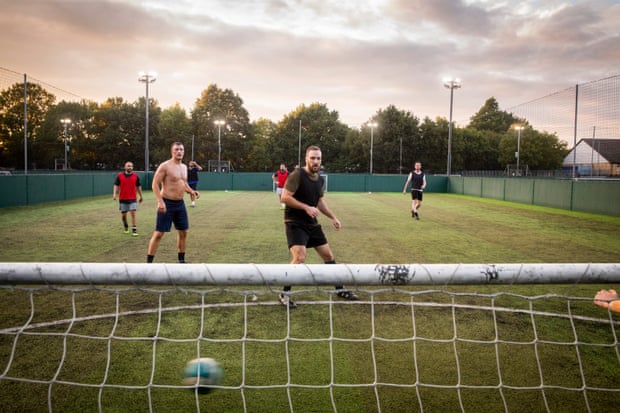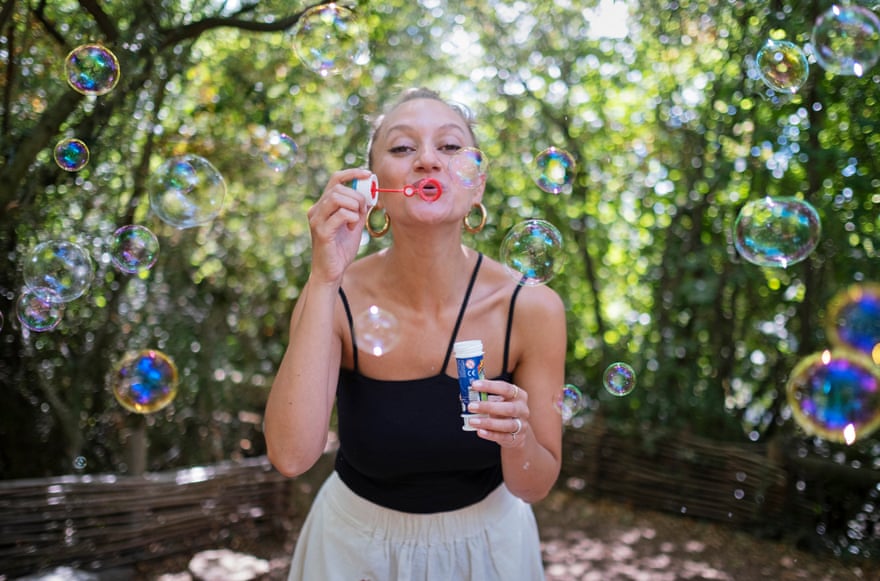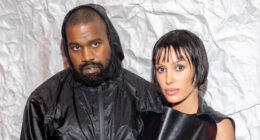Dance like no one’s watching – and six more ways to recapture childhood fun

It’s never too late to attempt an activity you might have missed out on as a kid. Learning to dance, skip, swim, blow bubbles, play football, or go to a funfair can bring you unexpected joy, as our writers discover
Skills such as riding a bike or learning to swim are often considered part of growing up – but not everyone gets to experience these childhood staples, and some only discover them much later in life. Drew Barrymore, who has spoken about her traumatic childhood in the past, recently shared TikToks of herself enjoying the experiences that, in a more conventional youth, might be considered unexceptional. In one, she laughs in pure pleasure at feeling the rain on her skin; in another, she dances with abandon in her living room. Here, seven writers describe belatedly embracing “childlike” endeavours – and experiencing the joy they can bring later in life.
Sadia Nowshin: ‘I can’t wait to frolic in the sea on my next holiday’
I have a vivid childhood memory, from around the age of nine, of clinging to an equally anxious friend as we squeeze our eyes shut and jump into the cold water of lane one. We emerge beaming with achievement, having entered the pool for the first time just a few months earlier, marking our last swimming lesson with a final, fearless leap of faith.

But that was the last time I went near a pool until years later, on a family holiday, when I discovered that, contrary to my expectations, swimming was decisively not like riding a bike. The shock had me scrambling back to safety, a fear of water flooding in. A cultural expectation for girls to cover up had already removed revealing swimming costumes from my wardrobe. This, coupled with teenage body-image issues, saw me vow to remain on dry land.
Then, earlier this year, I booked myself on to a beginner’s course of swimming lessons as part of a post-pandemic mission to break out of my comfort zone. I had thought my experience was unique, but quickly found that I was the youngest in a group of exclusively south and east Asian women chasing the same mission. We became sheepish swimming comrades, united by a desire to overcome the shame that comes with learning late, and encouraging each other at every metre milestone. I might not be winning races, but I no longer feel anxious every time I go over a bridge and will accept the next pedalo offer that is extended, with confidence, knowing that that a tumble into the water won’t result in a mortifying rescue mission. Most importantly, I’ve reclaimed the feeling of exhilaration I embraced as a child and can’t wait to frolic into the sea on my next holiday to make up for all the salty memories I’ve missed out on making.
Simon Hattenstone: ‘Skipping makes me feel like a king of the universe’
I was so jealous of people who could skip. I couldn’t work out the magic – was the rope going through them, across them, under, over? Whooosh! It didn’t matter. It was so fast and pure and beautiful.
I never skipped at school. I missed a few years, due to contracting encephalitis, which may well have been the skipping years. When I returned, it was all football. No boy skipped in the playground at secondary school unless he wanted his head kicked in. Well, this was the 1970s.
A few years ago, Jimmy, a sprinter, became part of our family. Wow, could he skip. He was mesmerising. I would watch his big toe rising every milli-second, thinking, how?

A boxing club opened near work. A brilliant way to get fit, people said, such fun. But skipping was part of the training. And I couldn’t skip. People would laugh at me. It’s not that I wasn’t willing to learn; I was convinced I couldn’t. I blamed it on the encephalitis, which can screw up perspective and coordination. Whatever the cause, it was humiliating.
One day, Jimmy brought home orange plastic skipping ropes to send back to kids in Sierra Leone. When everybody was out, I had a go. I tripped up. I’d jump on the rope or miss it all together. But I didn’t give up. I managed two skips, then three, and built up. It was the middle of lockdown and there was lots of time to practise. My sister came over and I showed her. “Wow – three!” she said. Then I changed technique. Instead of jumping with both feet, I’d lift my left foot, and it felt easier. Ten became 20, then 30. But I would get out of breath. Skipping was so much harder than running.
Gradually, the two came together – skipping and breathing. Now, I love the feeling. I’m slow and clumsy but on a great day I can get to a hundred without stopping. People laugh when they see me because I look so happy and childlike. They ask if I can launch off my right foot (no) and what other techniques I can do (none). I’m terrified of trying anything new in case I forget what I can already do. It feels like the first thing I’ve learned to do since kick-ups with a football when I was 11-ish. Occasionally, I can even hear the wind through the rope. It makes me feel like king of the universe. Whooosh.
Kerry Hudson: ‘At the funfair I was alive with my happy, deeply loved kid riding on my shoulders’
In my teens, the funfair was omnipresent – from our Great Yarmouth council estate, I could hear the screams from the Pleasure Beach rollercoaster. But, in the working-class towns of my earlier childhood, annual fairs always seemed to be for “other kids”. For us, the walk to the fair was punctuated by a fierce briefing from my hard-up single mum: “One ride; don’t ask for a single extra thing. Otherwise, you’re right home.”
My eyes lit up with the rainbow of lights and I stuck my tongue out to catch silky wisps of candyfloss floating through the air like new snow but there was always so much more that I wanted – a goldfish in a bag, doughnuts, a ride on the waltzers! – that I would spend a lot of time tussling with the natural childish urge to want, want, want and eventually I would always buckle and plead, plead, plead. The memory of my mum’s expression, when she had to open her purse to show me there were no more coins, twists my heart even now. Eventually, I learned not to ask; instead, I lingered in arcades snaking my fingers, smelling of tangy copper, into the payout slots in the hope of finding a forgotten two-pence piece.

I’m a mum myself now and, at Easter, Prague’s biggest funfair arrived. My happiness was twofold. I knew my toddler – though he wouldn’t have everything he demanded – wouldn’t see the stress on my face as I weighed up the waltzers against dinner. I had also just had life-saving airway surgery and, as I watched him delightedly devour “chimney cake” and bounce along to Haddaway, I was alive with my happy, healthy, deeply loved kid riding on my shoulders. Growing old, and getting to experience childlike pleasures alongside your children, truly is the greatest joy. Getting to ride the dodgems and waltzers as many times as I want is just an extra bonus.
Coco Khan: ‘Dance classes gave me a new appreciation of my body’
At school, it never occurred to me that I might like dance classes. Even when I was going to “nappy nights” – club nights for the under-18s – nurturing a love of raves that I still have now, it didn’t cross my mind to actually learn some moves.
READ RELATED: AFL great Billy Brownless has a new woman in his life six years after his marriage ended
Part of this was circumstance – being one of three kids in a single-parent family meant money was tight, and having different pickup times from school could be an impossible hurdle. But I have also wondered if culture played a role: many girls get into dancing through infant ballet classes, yet none of the south Asian girls from my council estate did them. By my teenage years, some of these same friends were facing active discouragement from performing arts or sport by their families. I couldn’t see anyone who looked like me doing it, so, perhaps, I deduced, it wasn’t for me.

Then, three years ago, I arrived at my regular gym looking for a class to find the only one available was dance. I went for it. The worst bit was the mirror. Dancing in a club is one thing, but seeing yourself in the cold light of day – the clumsy shortness of your limbs, and how parts of you continue to jiggle long after you’ve paused – takes some getting used to. Eventually, however, something clicked. Concentrating on the steps helped push my body insecurities away. Soon enough, a new, different appreciation of my body began: a love for what it can do, rather than how it appears.
These days, I dance once a week. Even when the pandemic forced studios to close, there were plenty of YouTube videos teaching the latest TikTok dance or a classic Britney routine (pro tip: add it to your karaoke routine and watch everyone lose their minds). To me, dance classes are win-win. It’s one of the best all-round exercises for improving strength, lung capacity and coordination; it requires no equipment and most people can participate at some level. When else in life do we get a deal this good?
Chris Godfrey: ‘I’m quietly confident that I’m now an asset to my football team’
My older brother Matt used to tell everyone that I had a foot problem: that’s how bad I was at football. I’m still not sure if this lie was to protect him or me from embarrassment. Still, it’s fair to say that my fervour for Arsenal off the pitch wasn’t matched by my ability on it. “I’d sometimes think to myself, ‘can he even see the ball?’” said my lifelong friend Josh. “We’d have been better off if you just stayed at home and played video games,” added his brother, James. And, to be fair, that’s eventually what I did.
But last year’s lockdown presented an opportunity to rectify the situation. There was an abundance of spare time and an urgency to be outdoors. I bought some new boots. I got my match fitness up (sprints, mainly). And I took a ball to my local park where I trained alone (and there is no sadder sight than a man in his early 30s, on his own in a park, teaching himself kick-ups and dribbling around cones). I watched YouTube videos, enlisted friends to critique my game, and repeatedly passed the ball against walls.

Eighteen months later, I’m playing five-a-side once a week. As a defender, I’ve taken my game from Shkodran Mustafi to Rob Holding (AKA “error prone” to “competent”). At the rate I’m going, I’ll soon be as elegant on the ball as Ben White, capable of effortlessly dribbling out of defence and laying on silky attack-minded passes. My teammates agree. “I couldn’t believe how relaxed he was on the ball along with his first touch, control and decision making,” says personal trainer Matt Godfrey, my aforementioned brother, after a recent a game. “It’s a proud feeling seeing all the things we’ve been teaching him come together.”
“Most improved this season: Chris. Solid defender,” says Rob Timanti, which means a great deal, because Rob is a baller. “It’s been really great to see Chris go from strength to strength,” says Adam Hartnell, who is as good a coach as he is a player. “I knew it would just be about confidence and after he started getting more minutes on the pitch things just completely changed. He now keeps up with even the best players.” And, while it may be four games without a win at the time of writing, I’m quietly confident that I’m now an asset, not a hindrance.
Saima Mir: ‘I plan to be a silver-haired 70-year-old, sparring with my twentysomething son’
At 47, I am a latecomer to martial arts. Growing up, my brother and I would scour the shelves of Blockbuster for films such as Kickboxer, Bloodsport, China O’Brien, and, of course, anything starring Bruce Lee. Despite loving the idea of learning to fight, I didn’t think it was an option for a brown, Muslim girl from inner-city Bradford. If someone had told me then that Muslim masters used martial arts as a spiritual tool, and that Islamic teachings of self-control and restraint are mirrored in disciplines such as Silat and Wushu, maybe I would have thought differently.
When I heard that one of the dads at my children’s school was starting a club, I signed my son up. Sifu Carl Jackson had amassed 17 British titles, three European titles and six world championship silvers, and had achieved the feat of creating a club that felt hugely inclusive. Knowing my interest in the sport, my husband nudged me to sign up too. I was nervous that first day, but the minute my boxing glove made contact with a pad, I knew I was where I belonged. Something about it felt comforting. I was hooked.

My Saturday mornings are now spent learning to jab, cross, kick and power punch with women ranging in age from their 50s to teenagers. Some members fight in hijab. We learn Jeet Kune Do, the martial arts form devised by Bruce Lee, which of course makes it incredibly cool. I’m not as fast or slick as I would have been in my youth, and my knees aren’t what they used to be, but I’ve passed my yellow tag.
With work, book festivals, and three children, my free time is short. I choose to spend it only doing things I like, with people I love. Martial arts ticks these boxes. I’ve learned not to regret my life choices, but I do wonder about the chances I let slip by. I won’t do that again – I plan to be a silver-haired 70-year-old, sparring with my twentysomething son.
Jenny Stevens: ‘I found myself staring at the bubbles with wonder’
My sanity was fragile and I was looking for a reason to keep going. I found it, unintentionally, in the glossy, iridescent, unfathomable magic of a bubble. Pop!
I had just been discharged from a psychiatric unit. My relationship, I had finally realised, was bad. I left it and my flat behind, and was taken in by two close friends and their 18-month-old baby, Nico. I was fascinated by him: his shiny brand-newness, and how unencumbered he was by thoughts of the kind that were strangling my potential happiness: the hurt and the pain. He laughed with abandon, farted with glee, and woke up every morning yelling the only word he knew: “Achoo!” His delight at the most mundane events, like the ping of the microwave or counting the stairs, was infectious.

During summer 2018, my friend brought home a bottle of bubbles. I don’t remember liking them much as a child – kids at school lobbing the soapy water at each other put me off – but, as I blew through that little ring, and a bubble grew and then detached itself into the air, Nico looked on in silent rapture. It was one of the purest things I had ever seen: his undiluted joy at witnessing something as humble as a bubble for the first time.
It was, I thought, what medical professionals were talking about when they spoke to me of mindfulness. There was absolutely nothing else in Nico’s mind at that moment but the smooth surface of that bubble, the way it wobbled into the air and its colour shifted from a blue sheen to a pink and silver one. I found myself staring with that same wonder – what a thrilling, beautiful and completely baffling thing. Sometimes, when I feel hopeless, I think of Nico seeing bubbles for the first time and remember that there is always someone looking at the world with new eyes – and that joy really is both the smallest and biggest of things. Now, I blow bubbles whenever I can.
Source: Health & wellbeing | The Guardian





